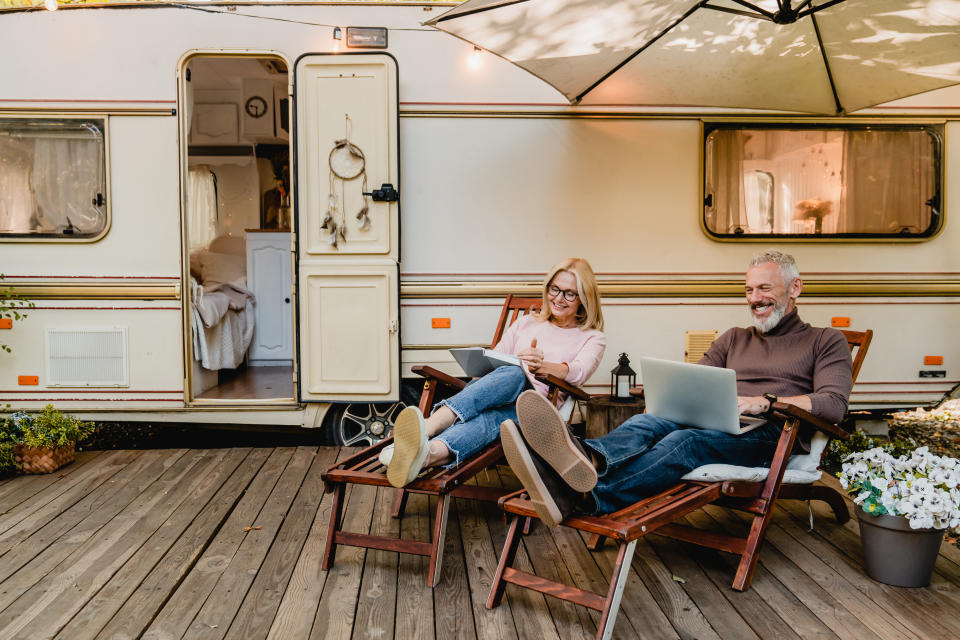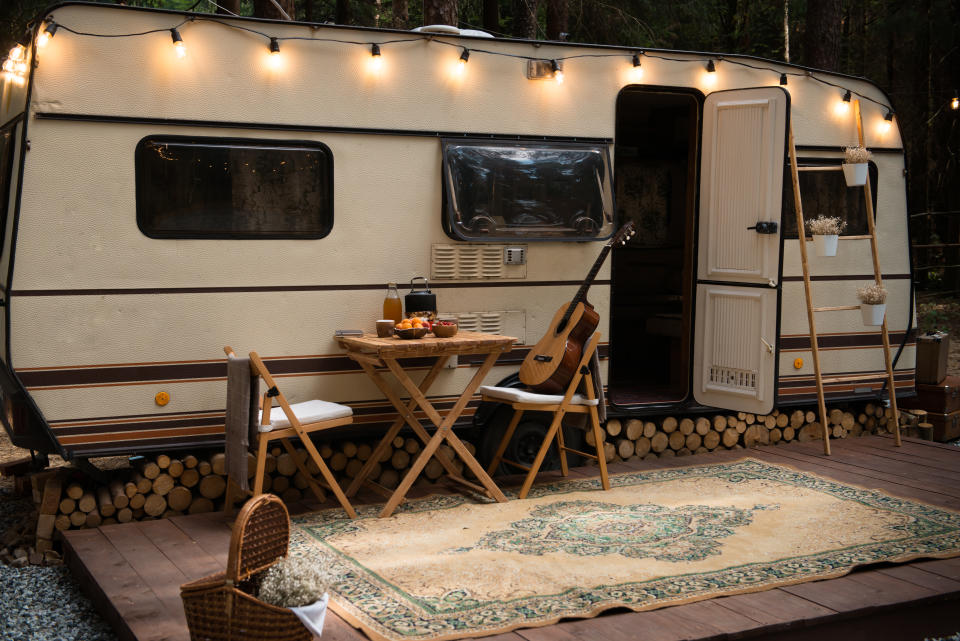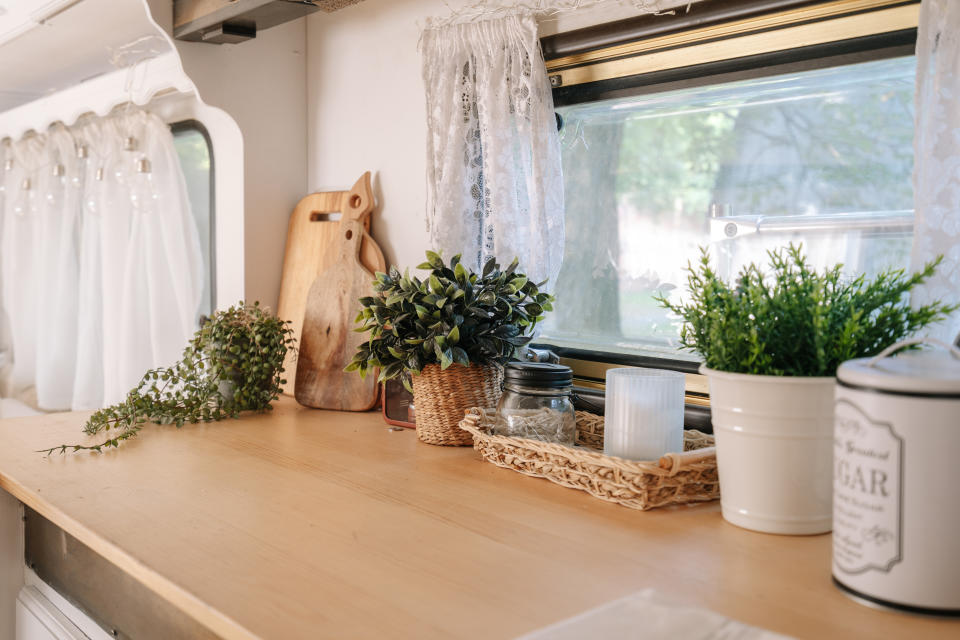RV-ing 101: What To Expect When You Buy and Travel by RV
Before you make any big investment on living small, it’s good to do your homework. The type of RV that's best for you can depend on the size of your family, your budget, and the destinations you're hoping to hit. Luckily, the varieties and options are endless when it comes to choosing a recreational vehicle, and there are tons of resources out there to make your purchase easier. We checked in with the folks at Go RVing, the go-to organization for all things camper and motor home–related, for answers to our most pressing questions. Know the pros and cons before making the big purchase.
What are the key things people should consider before buying an RV?
Start by deciding what type of RV you want — motor home or travel trailer — and the budget you have to spend. Is it going to be new or used? You can buy a great tent camper for under $10,000, or spend $200,000 or more on a beautiful motor home. Keep in mind there are many options in between those price ranges. If you choose a travel trailer, do you have the proper tow vehicle? Many travel trailers now can be towed by the family SUV, but it’s important to verify how much weight your vehicle can handle.
Most first-time RVers will visit a local RV dealer or an RV Show to browse the many different types of RVs and options that are available. Once you’ve decided what you like, you can rent an RV from a local dealer or a peer-to-peer rental company like outdoorsy.com or rvshare.com to try out different models.
When choosing an RV, think about the space you’ll need to sleep your family or friends. In addition to a private bedroom, most RVs have dinettes and sofas that turn into beds. Some even have bunk beds that are perfect for the kids and boast plenty of storage inside, as well as additional storage for all your gear underneath. That means you can bring your golf clubs, bicycles, and your favorite toys and games along for the ride to keep the kids entertained.
Where do you park an RV when you're not using it?
Some communities don’t allow overnight parking, so you’ll need to look at renting a storage space. Some people store their RV on their property, and some homes (especially in the south and southwest) have a pad along the side of the house for RV parking. Smaller RVs like tent trailers and van style campers may fit inside an existing garage.
Do you need a special license to drive an RV?
Most states do not require a special driver’s license to operate a motor home or tow a travel trailer. If you choose a motor home that’s more than 26,000 pounds, you may need a commercial driver’s license. If this is your first time driving or towing an RV, you may want to practice driving. Try it out in an empty parking lot.

Where do I learn how to operate my RV — power sources, sewage, etc?
When you purchase an RV at a dealership, the employees will walk you through and show you how to operate the different systems. It’s surprisingly easy. Plugging into power is just like plugging in a lamp. Connecting the water is as easy as attaching a garden hose. One of the best places to start is at gorving.com. We have lots of videos created for newbie RVers that can teach you most everything you’ll want to know. There are also many different Facebook groups where you can ask questions, and YouTube videos that can show you how to do things.
What are the typical sizes of RVs?
Travel trailers range from 12 feet up to more than 30 feet in length depending on the model. A popular entry-level trailer is the tent camper by Forest River (forestriverinc.com). The teardrop-style trailer by Little Guy Max (golittleguy.com) is also great, but it tends to be a little more expensive.
Midsize travel trailers are the most sought-after. They can range in size from 14 feet up to 30 feet or longer. Travel trailers by Jayco are very popular because of the attractive size and price. The largest of the travel trailers are called fifth wheel. They connect to your pickup truck via a hitch in the truck bed. These tend to be more luxurious and can be up to almost 42 feet in length.
Motor homes range in size as well. The smallest is the van camper, also known as a Type B motor home. It ranges in length from 16 feet to 21 feet and is more lightweight and more fuel-efficient than larger models. Some of these compact RVs are only a little larger than a full-size SUV. Many can easily maneuver through country roads and city streets alike — even downtown parking is more manageable. But don’t let the smaller size fool you; a compact motor home still boasts many of the amenities as the larger homes on wheels, including a comfy bed, kitchen, and bath.
Next up in size is the most popular model: the Type C motor home. They range from 21 feet to 35 feet and are easily recognizable by the over-the-cab area that is most often used as an optional sleeping area. These vehicles are great for families because they can sleep four to eight. Amenities are similar to those in the Type A motor homes. Most have slide outs to increase the living space. Some come equipped with outdoor kitchens and big-screen TVs, making these motor homes perfect for tailgating.
Type A motor homes are generally the largest. They range from 25 feet to more than 40 feet in length, with top-of-the-line amenities. Slide out walls dramatically increase living space at the push of a button. Relax on soft leather sofas in front of your fireplace and enjoy meals you make in your gourmet kitchen equipped with a full-size stove, refrigerator, and often a dishwasher. Many have large wardrobes for clothing storage, a full bath with tub, washer and dryer, satellite TV — along with several big-screen TVs — and even a central vacuum!
Typically, people start with a smaller motor home and realize that they want something bigger or need different features or floor plans. Anyone new to RVing should start by renting a few different models to get a feel for what they like and what they really need, and how it fits into their budget.
How do you find parks that fit your needs?
Start at gorving.com and use our campground locator. If you’re looking for kid-friendly sites, search out a Jellystone Park or KOA Campground. Both cater to kids and adults with plenty of activities. Some even have playgrounds, mini golf, basketball hoops, cornhole, and extra fun features like water parks, zip lines, and hiking trails. You should also check out sites like campgrounds.rvlife.com or harvesthosts.com. Try and join a Facebook group located in an area where you’d like to visit and talk to other campers. Fellow RVers are a good resource for advice and are generally eager to share about experiences that were great (and not so great). State and national parks are often wonderful places to camp, but you’ll need a reservation for the most popular parks, like Yellowstone for example.
How often do RVs have to be serviced?
RV engines need to be checked and serviced just like the family sedan. Read the owner’s manual to find out the particular details of your rig.

What upgrades do you suggest for people who are RVing for long periods of time?
The No. 1 upgrade is a new mattress that fits your sleep style. Outdoor TVs and kitchens are very popular, and people love to outfit their RVs with an outdoor fridge. It makes it easy to get a cold drink and a snack without having to go inside. Folding patio chairs, fire pits, and portable grills are must-haves for tailgaters. Some choose to add an outdoor rug to help jazz up the outdoor space and keep the dirt outside. Battery operated lamps, fairy lights, and lanterns are nice too for a bit of ambience.
How can I personalize the the inside of my RV?
Many people replace the curtains, which sounds small, but swapping out a drab brown-and-beige fabric for brightly patterned drapes goes a long way! Coordinating pillows and blanket throws are both useful and add an extra blast of personality. In lieu of dragging around photo albums or piling framed photos, it’s fun to display pics via a digital photo frame. They can store hundreds of photographs and the ever-changing pictures bring up lots of fun memories. Command-style hooks can hold all sorts of items — both practical and pretty — and they’re lightweight and easy to remove.

A version of this article appeared in our partner magazine Tiny Homes.

